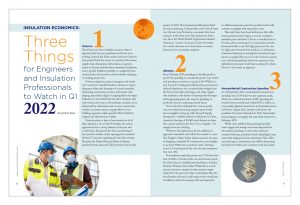Insulation Economics: Three Things for Engineers and Insulation Professionals to Watch in Q1 2022
- Omicron
There have now been multiple occasions when it appeared that the post-pandemic world was soon arriving. Instead, the Delta variant and now Omicron have pushed back the return to normalcy. That means supply chain disruptions will continue, as governments in Europe and elsewhere reinstitute lockdowns and as people withdraw partially or completely from certain forms of economic activity, whether shopping or working at job sites.Owners, engineers, project managers, and insulation contractors should therefore continue to expect shipment delays and shortages of certain materials. Delivering construction services will remain challenging, especially in light of ongoing labor shortages. Indeed, it is conceivable that the labor situation will only worsen over time as the industry continues to be hammered by retirements and as some construction workers are drawn away to supply effort to nonbuilding segments, where growth will be fueled by stepped-up infrastructure outlays.Omicron places a layer of uncertainty on all of these dynamics. As of mid-November, the nation appeared set for a strong balance of the year and a solid 2022. Job growth has been accelerating of late, and the number of job openings has remained elevated. Consumer spending also has been strong. Recently, the Federal Reserve Bank of Atlanta predicted 8.6% national GDP growth for the fourth quarter of 2021. The International Monetary Fund has been predicting 5.2% growth in the United States over the next year. However, economists have been racing to revise these and other projections lower, ever since the World Health Organization labeled Omicron a “variant of concern” in late November. As a result, observers now deem those economic forecasts to be excessively sanguine. - Inflation
Since February 2020, spending on durable goods is up 28.1%, spending on nondurable goods is up 18.4%, and spending on services is up just 2.8%. While it is easy to point to inadequate infrastructure, government-induced shutdowns, the occasional ship wedged into the Suez Canal, labor shortages, and other supply-side maladies as the drivers of input/goods shortages and burgeoning prices, the surge in spending on goods has been an underappreciated factor.Given the level of demand for various goods, even smoothly functioning supply chains would have struggled to keep up with demand. Supply disruptions—whether related to blackouts in China, America’s shortage of 80,000 truck drivers, or ships that cannot unload at the Port of Los Angeles—are simply more eye-catching.Whatever the explanatory factors, inflation is apparent everywhere and will be for months to come. The Freightos Baltic Index, which measures the price of shipping a standard 40’ container by ocean freight, is up about 600% since pandemic onset. During a recent 12-month period, the cost of truck transportation rose 14%.For insulation materials, prices rose 17.5% from the start of 2020 to October 2021, the most recent month for which data are available from the Bureau of Labor Statistics’ Producer Price Index. While this is a modest price increase compared to the meteoric surges observed in the prices for other commodities like softwood lumber and steel, it still outpaces the overall rate of inflation observed economy-wide and represents an additional pressure point for an industry that will continue to grapple with rising labor costs.
That said, there have been indications that inflationary pressures have begun to recede. Insulation materials prices declined 1.3% on a monthly basis in October, after increasing for 13 consecutive months. Economists like to say that high prices are the cure for high prices because they result in a combination of demand destruction and greater incentives for producers to supply. Were it not for the Omicron variant, one could have predicted with some assurance that inflationary pressures would have continued to abate. Now, it is not nearly as apparent.
- Nonresidential Construction Spending
As of September 2021, nonresidential construction spending was 10.7% below its pre-pandemic peak, which was attained in January 2020. Spending has trended lower recently and totaled $791.2 billion on a seasonally adjusted, annual rate in September, down 0.6% from August 2021 and just 0.2% above the pandemic low point attained June 2021. Nonresidential spending is at roughly the same level observed in February 2019.While some publicly financed segments like water supply and sewage and waste disposal have rebounded, spending in every other subsector remains below pre-pandemic levels. Spending in segments like lodging has been devastated. New office and retail space construction also will be hamstrung by behavioral shifts such as remote work and online shopping. Meanwhile, data and fulfillment center construction will remain fast and furious, along with a number of federal government spending-infused public segments. Insulation contractors likely will find new school construction and school modifications as exceedingly fertile lines of work.
Looking Ahead
While America’s economy will end up delivering big numbers during 2021’s final quarter, the initial stages of 2022 could usher forth a period of economic weakness. It is simply too soon to tell. If and when Covid is under control, the U.S. economy should surge forth once again, given strong consumer demand for goods and services, strong business demand for productivity-enhancing equipment in the context of skills/labor shortages, and elevated public-sector outlays, including from state and local governments.

